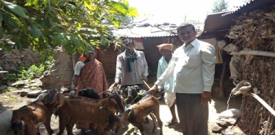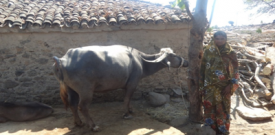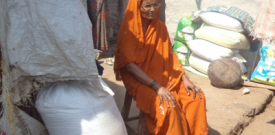Case Study: (Livelihood)
 1.Sunita w/o Basker a resident of Chikli (J) Villageof Bidar district1. Sunita w/o Basker a resident of Chikli (J) Villageof Bidar district, belongs to the Schedule caste Category. She is a landless labourer; she gets work whenever there is availability of work in the village which is mainly in the agricultural season; even then she does not get work every day but is restricted to agricultural operation which includes sowing, weeding and harvesting of agriculture produce. After the completion of the season she is mostly unemployed. To avoid this she is wanted to purchase a few goats but she had no capital. That is when she came to know about the HUVF, NABARD and MYRADA project with its focus on Self Help Groups and livelihood support for enhancing the income of the landless. She joined the Self Help Group and participated in the livelihood survey and expressed her interest of rearing goats. In the second year of the project she got a grant of Rs. 10000/ from the project and 15000/ loan from Sanghamitra Rural Financial Systems through self help group. Now she has 4 goats and started to rear those goats and there is no need to go search of work in others field. She is yet to realise the income from the goats but she is confident that she will get good income from the sale of these goats. Now she is happy and satisfied about the work she is engaged.
1.Sunita w/o Basker a resident of Chikli (J) Villageof Bidar district1. Sunita w/o Basker a resident of Chikli (J) Villageof Bidar district, belongs to the Schedule caste Category. She is a landless labourer; she gets work whenever there is availability of work in the village which is mainly in the agricultural season; even then she does not get work every day but is restricted to agricultural operation which includes sowing, weeding and harvesting of agriculture produce. After the completion of the season she is mostly unemployed. To avoid this she is wanted to purchase a few goats but she had no capital. That is when she came to know about the HUVF, NABARD and MYRADA project with its focus on Self Help Groups and livelihood support for enhancing the income of the landless. She joined the Self Help Group and participated in the livelihood survey and expressed her interest of rearing goats. In the second year of the project she got a grant of Rs. 10000/ from the project and 15000/ loan from Sanghamitra Rural Financial Systems through self help group. Now she has 4 goats and started to rear those goats and there is no need to go search of work in others field. She is yet to realise the income from the goats but she is confident that she will get good income from the sale of these goats. Now she is happy and satisfied about the work she is engaged.
 2.Kasturi w/o Yeshappa resident of Chikli (J)[/caption]2. Kasturi w/o Yeshappa resident of Chikli (J), her major occupation is labour. She used to engage in the labour work during the agricultural season which provided her employment only for six months; this also was irregular since the area is dry and rainfed and has only one crop, viz. Kharif. In lean agricultural season she used to migrate to Hyderabad in search of work and used to come back in the month of June. She explained the hardship and difficulties faced while migration. It disturbs the family and she could not concentrate on the health and education of her children. When livelihood survey was undertaken by the project staff her name was included in the livelihood list. In the second year of the project she purchased a buffalo with a grant of Rs.10000/- from the project and Rs. 15000/ as a loan from Sanghamithra under the livelihood activities of the project. After purchasing the buffalo she stopped migrating to Hyderabad and was able to focus on her children’s education. She gets 4 litres of milk per day from the buffalo. She consumes a part of it and sells the rest. The sale of milk brings in Rs.50 per day. In addition to this regular income now she has a calf which will provide an additional income in future.
2.Kasturi w/o Yeshappa resident of Chikli (J)[/caption]2. Kasturi w/o Yeshappa resident of Chikli (J), her major occupation is labour. She used to engage in the labour work during the agricultural season which provided her employment only for six months; this also was irregular since the area is dry and rainfed and has only one crop, viz. Kharif. In lean agricultural season she used to migrate to Hyderabad in search of work and used to come back in the month of June. She explained the hardship and difficulties faced while migration. It disturbs the family and she could not concentrate on the health and education of her children. When livelihood survey was undertaken by the project staff her name was included in the livelihood list. In the second year of the project she purchased a buffalo with a grant of Rs.10000/- from the project and Rs. 15000/ as a loan from Sanghamithra under the livelihood activities of the project. After purchasing the buffalo she stopped migrating to Hyderabad and was able to focus on her children’s education. She gets 4 litres of milk per day from the buffalo. She consumes a part of it and sells the rest. The sale of milk brings in Rs.50 per day. In addition to this regular income now she has a calf which will provide an additional income in future.
Case Study: (Labour)
 3.Sharifa Begum w/o Azim Khan is a landless labourer belonging to the Muslim community[/caption]1. Sharifa Begum w/o Azim Khan is a landless labourer belonging to the Muslim community. She used to work as wage labourer in the village for Rs. 50/ day during agriculture season. During lean period she had to remain unemployed and without any income. After the watershed work started under the HUVF/NABARD land treatment activities started in the farmers’ field and she started to get work as part of these activities. She worked six months under the project and earned Rs. 14000/. This was of great help for her family. She got a bulk amount in her hand. It helped her repay a loan of Rs. 5000/ taken from the money lender and Rs. 2000/ from the Self help group. At the same time she did not face any difficulty in making weekly savings with the self help group. The remaining amount was used for self. Now she is very happy and continues to work under the project.
3.Sharifa Begum w/o Azim Khan is a landless labourer belonging to the Muslim community[/caption]1. Sharifa Begum w/o Azim Khan is a landless labourer belonging to the Muslim community. She used to work as wage labourer in the village for Rs. 50/ day during agriculture season. During lean period she had to remain unemployed and without any income. After the watershed work started under the HUVF/NABARD land treatment activities started in the farmers’ field and she started to get work as part of these activities. She worked six months under the project and earned Rs. 14000/. This was of great help for her family. She got a bulk amount in her hand. It helped her repay a loan of Rs. 5000/ taken from the money lender and Rs. 2000/ from the Self help group. At the same time she did not face any difficulty in making weekly savings with the self help group. The remaining amount was used for self. Now she is very happy and continues to work under the project.
Case Study – Livelihoods
Shadullasab Meerasab is a 58 years old resident of Jambgi (D) village, Aurad taluka, Bidar District. His family consists of 10 members including his wife and children. He owns seventeen acres seventeen Gunte of agriculture land in survey No.11b of the village. The family’s main source of income agriculture; he also does some part time masonry work. The land is predominantly rain fed and is not fertile due to soil erosion. In addition to this, land to an extent of 8 acres was not under cultivation.
In 2011, during Kharif season, the yield from his land was as follows:
– Black gram – 3 Quintals/acre
– Green Gram – 1 Quintal/acre
– Hybrid Jawar-4 Quintal/acre
– Red Gram- 50 Kg/acre
– Green gram was only one quintal per acre
– Red gram was 50 kg/acre.
After the intervention of the project in the watershed activities, he took up area treatment works in his field is as per plan. The land treated by Myrada during the year was about 5.6 ha (14 acre) and the total cost of the treatment was Rs. 33355/- including 25% contribution to the village committee.
He says due to intervention of the watershed yield during the year 2012 is:
– Black Gram-4 Quintal
– Green Gram-3 Quintal
– Soya-10 Quintal
He has already harvested two quintals of Green Gram and is expecting a harvest of 12 Quintal of Red Gram. Apart from this he was not sure how to utilize the 8 acre of land which he had left uncultivated. After the intervention he initiated horticulture activities in 4 acres of waste land. He planted 400 plants, such as Mango-50, Lemon-200, Tamrind-100, Gauva-25, Others-25. There has been a 100% survival rate of plants (as of 30th Sept 2012). A most interesting innovation of his has been the use of empty glucose bottles for drip irrigation system.
He said an exposure visit to farmers’ fields in Zaheerabad Andhra Pradesh (to the project area of Deccan Development Society) was very useful. The main topics covered in the exposure were organic farming, pest management & integrated crop system. He adopted many of the systems for all horticulture plants and red gram crop. He has four pits for Vermi compost. He added that he stopped migrating since he is getting good crop yield & will continue the practices that he has adopted. He is very happy with the intervention.

